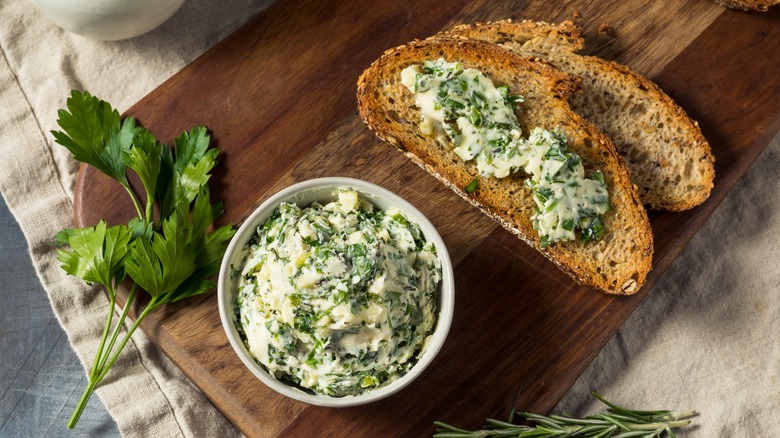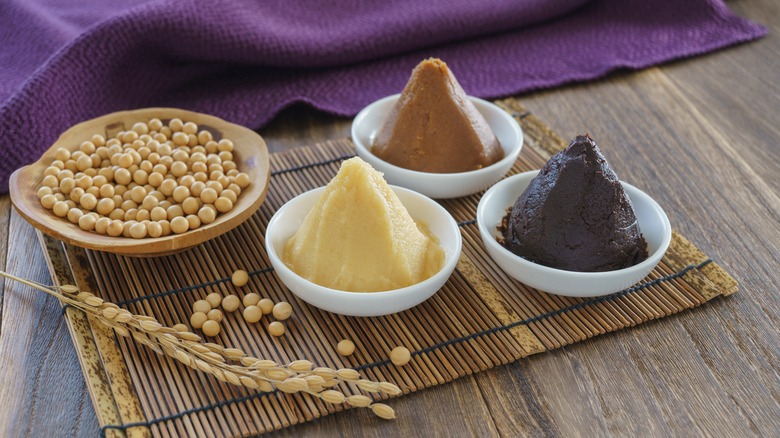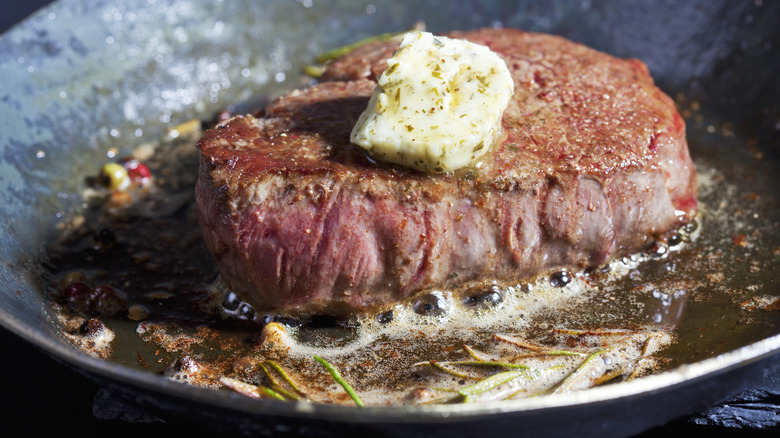This Umami-Filled Compound Butter Is The Only One You'll Ever Need
As Julia Child once said, "With enough butter, anything is good." Whether you use it to fry up some breakfast, spread it plain on bread, or mix it into all your favorite baked goods, the delicious stick of golden fat helps flavor dissolve into it, improving everything immeasurably. The only thing better than butter? Compound butter. Compound butter is a simple mixture of good-quality unsalted butter and various flavorful ingredients, usually herbs and seasonings. One atypical ingredient that's perfect for compound butter is miso paste. There are different kinds of miso paste with slightly different flavor profiles you can experiment with, but they all share the most important trait: they introduce more umami to your butter.
Umami is Japanese for "a pleasant savory taste." Unlike the other taste groups that usually come on strong, umami is subtle, adding richness and depth rather than overriding. The umami in miso paste is also joined by a fair bit of salt, meaning it's essentially a flavor turbocharger for your compound butter. Whether you want to add more ingredients on top is up to you.
How different miso pastes affect compound butter
In the United States, you're mostly going to find three kinds of miso paste, separated by their color. Each has its own unique flavor profile that's best used with certain dishes, but they're still similar enough that you can use them interchangeably in a pinch. The most widely made and available miso paste is white, or shiro. It has the mildest taste of the three, with a slight hint of sweetness behind it. Because of its mildness, it's the best choice for a general compound butter you can use when plain butter doesn't cut it.
Yellow miso, also called shinshu, has more flavor than white miso, with nice earthy notes and a touch of acidity. It's perfect for dishes that use butter as a main ingredient, such as buttered noodles or brown butter sauces. The final, strongest miso commonly available stateside is red, or aka. It has the longest fermentation process of the three, which is what develops its red color — though some aka miso is fermented long enough to turn dark brown or even black. Its flavor is nutty, salty, and intense, so it's best used in similarly strong dishes, so its flavors don't overpower the rest of your meal.
The best recipes for miso compound butter
To reiterate, any miso you may have on hand can be incorporated into butter and used in any recipe. You may, for example, want to use less red miso than you would white miso for delicate meals, but a balance can always be struck. With that said, white miso compound butter is perfect for sneaking that extra umami in without altering a recipe's flavor profile. You can use white miso in chocolate cake to make each bite even more decadent, or give caramel popcorn the miso treatment for an extra edge of sweetness and saltiness.
The more flavorful yellow and red miso compound butters are excellent for savory dishes. Because of yellow's earthy notes, this miso melds beautifully with mashed potatoes, especially since common mashed potato mix-ins such as garlic, cheese, and bacon also boost umami. Meanwhile, red's stronger flavors go perfectly with meat and seafood. Grilled shrimp tossed in miso butter can be a quick and easy meal. Or, you can plop a pat of red miso compound butter on a freshly cooked steak and watch the meat drink it up as it melts.


